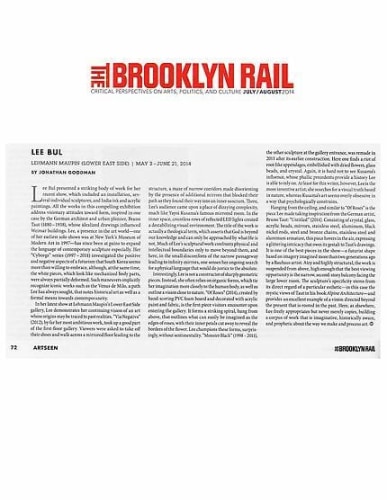
Lee Bul
By: Jonathan Goodman
Lee Bul presented a striking body of work for her recent show, which included an installation, several individual sculptures, and India ink and acrylic paintings. All the works in this compelling exhibition address visionary attitudes toward form, inspired in one case by the German architect and urban planner, Bruno Taut (1880 – 1938), whose idealized drawings influenced Weimar buildings. Lee, a presence in the art world—one of her earliest solo shows was at New York’s Museum of Modern Art in 1997—has since been at pains to expand the language of contemporary sculpture especially. Her “Cyborgs” series (1997 – 2011) investigated the positive and negative aspects of a futurism that South Korea seems more than willing to embrace, although, at the same time, the white pieces, which look like mechanized body parts, were always partially deformed. Such maneuvers implicitly recognize iconic works such as the Venus de Milo, a path Lee has always sought, that notes historical art as well as a formal means towards contemporaneity.
In her latest show at Lehmann Maupin’s Lower East Side gallery, Lee demonstrates her continuing vision of an art whose origins may be traced to past realities. “Via Negativa” (2012), by far her most ambitious work, took up a good part of the first-floor gallery. Viewers were asked to take off their shoes and walk across a mirrored floor leading to the structure, a maze of narrow corridors made disorienting by the presence of additional mirrors that blocked their path as they found their way into an inner sanctum. There, Lee’s audience came upon a place of dizzying complexity, much like Yayoi Kusama’s famous mirrored room. In the inner space, countless rows of reflected LED lights created a destabilizing visual environment. The title of the work is actually a theological term, which asserts that God is beyond our knowledge and can only be approached by what He is not. Much of Lee’s sculptural work confronts physical and intellectual boundaries only to move beyond them, and here, in the small discomforts of the narrow passageway leading to infinity mirrors, one senses her ongoing search for a physical language that would do justice to the absolute.
Interestingly, Lee is not a constructor of sharply geometric pieces. Instead, she often relies on organic forms, which tie her imagination more closely to the human body, as well as outline a vision close to nature. “Of Roses” (2014), created by hand-scoring PVC foam board and decorated with acrylic paint and fabric, is the first piece visitors encounter upon entering the gallery. It forms a striking spiral, hung from above, that outlines what can easily be imagined as the edges of roses, with their inner petals cut away to reveal the borders of the flower. Lee champions these forms, surprisingly, without sentimentality. “Monster Black” (1998 – 2011), the other sculpture at the gallery entrance, was remade in 2011 after its earlier construction. Here one finds a riot of root-like appendages, embellished with dried flowers, glass beads, and crystal. Again, it is hard not to see Kusama’s influence, whose phallic precedents provide a history Lee is able to rely on. At least for this writer, however, Lee is the more inventive artist; she searches for a visual truth based in nature, whereas Kusama’s art seems overly obsessive in a way that psychologically constrains.
Hanging from the ceiling, and similar to “Of Roses” is the piece Lee made taking inspiration from the German artist, Bruno Taut: “Untitled”(2014). Consisting of crystal, glass, acrylic beads, mirrors, stainless steel, aluminum, black nickel rods, steel and bronze chains, stainless steel and aluminum armature, this piece hovers in the air, expressing a glittering intricacy that owes its gestalt to Taut’s drawings. It is one of the best pieces in the show—a futurist shape based on imagery imagined more than two generations ago by a Bauhaus artist. Airy and highly structural, the work is suspended from above, high enough that the best viewing opportunity is the narrow, second-story balcony facing the large lower room. The sculpture’s specificity stems from its direct regard of a particular esthetic—in this case the mystic views of Taut in his book Alpine Architecture—and provides an excellent example of a vision directed beyond the present that is rooted in the past. Here, as elsewhere, Lee freely appropriates but never merely copies, building a corpus of work that is imaginative, historically aware, and prophetic about the way we make and process art.
